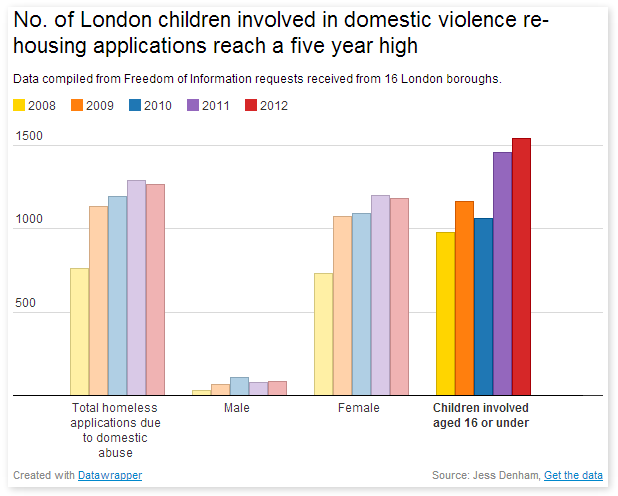
Victims of domestic violence in London are facing the longest wait for re-housing in five years, with the average household forced to remain in temporary accommodation for just over two years, writes Jess Denham.
The number of women seeking re-housing due to domestic abuse has risen by 62% since 2008 and remained steady in recent years, suggesting that support for those struggling is still lacking.
In 2012, 1182 women applied for re-housing on the grounds of domestic abuse compared to 81 men, while many more are suspected to be suffering in silence.
Of the 16 London boroughs that responded to requests for information for 2012, 1263 applications for re-housing had been submitted by domestic violence victims in a rise of 7% from last year.
Hammersmith and Fulham, Hillingdon and Bromley received the most applications from victims with 187, 181 and 162 applications respectively. Most of these applicants have yet to be properly re-housed.
Data obtained under the Freedom of Information Act revealed that the average victim permanently re-housed by Harrow Council in 2012 had waited over seven years since application. Wandsworth and Camden’s applicants had waited more than five.
Priority need applicants are offered temporary accommodation, but opportunities for permanent re-housing are in dire shortage.
A spokesperson for Harrow Council’s housing department commented:
“Applications from victims of violence in priority need are given emergency accommodation, temporary accommodation or are secured women’s refuge space. Sadly, due to the chronic shortage of permanent accommodation in Harrow, they will wait many years before they receive permanent housing.”
Judith Higgin from homelessness charity St Mungo’s said:
“From a survey of our 1700 female clients we know that 35% of women who have slept rough left home to escape domestic abuse. We also know that women will take other decisions such as staying in abusive relationships rather than sleep rough, which makes it difficult to know the true extent of the issue.”
The number of children listed in re-housing applications by domestic violence victims has jumped by 58% in the last five years. There were 1539 children involved across 16 boroughs in 2012 compared to 977 in 2008, perhaps reflecting a rise in family instability and violence during tough economic times.
(EDIT: This post was updated with a visualisation on 9 May 2013.)